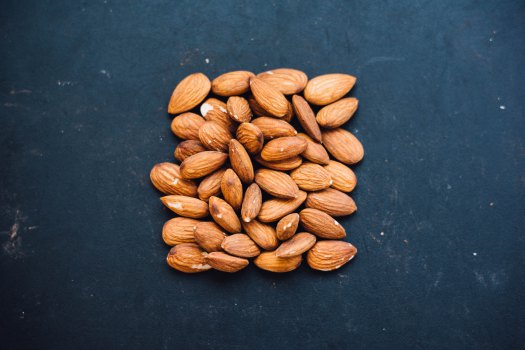Let me start by saying that hand crafted almond milk, is the bees knees. If there is a (totally non-bandwagon) bandwagon for making your own nut milks, I didn’t just hop on, I threw myself on there and I’m not giving up my seat for anyone.
For years I went back and forth between buying the watered down, sometimes flavoured, emulsifying gum filled almond milk from the grocery store and returning to regular dairy. I remember reading somewhere that almond milk was a better alternative to cow’s milk, followed by a list of the numerous health benefits. The idea of making your own nut milks, always bounced around Pinterest, blogs I read, etc. but as much as I aspired to be the kind of person who made their own everything, I could never find the time or motivation.
At one point, I remember learning about carrageenan: an extraction from an edible red seaweed that is often used in dairy (aka tetra packs of almond milk) as a thickener. But only after being approached in the dairy aisle at the supermarket, by a very (shall I say…) passionate lady, about how awful this substance was, did I actually stop and think that maybe I should look into it.
And boy am I glad I did.
Carrageenan, as it turns out has no nutritional value, and in fact isn’t actually digestible. This thickener found in many “natural” products, causes inflammation in body tissues, which then causes chronic inflammation (say hello to heart disease, Alzheimer’s and Parkinson’s), and has been found to accelerate cancers.
Note: If you’d like more information, this blog post from Wellness Mama goes into great detail about her Carrageenan research, and @Dr.Weil (go follow him on Instagram and Twitter) also does a great job explaining it’s dangers.
Long story short, relying on store-bought nut milks is silly and making your own is way better (and easy peasy).
 Photo by chuttersnap on Unsplash
Photo by chuttersnap on Unsplash
Why Almond Milk?
Almond milk (or nut milks in general) are a great plant-based alternative to cow’s milk, goat’s milk or soy (which can upset hormones such as estrogen). Almond milk is lower in calories, has comparable micronutrient levels to dairy, and if you don’t take well to high amounts of dairy (like me), it won’t create any inflammation in your body.
Sprouting Your Almonds… Do you have to?
The process of sprouting is simply soaking overnight in filtered salt water, rinsing, and repeating until the nuts produce a tiny sprout. This usually only takes 24 hours. Not so hard, right?
My first attempt at sprouting was with red lentils. It ended with a moldy mess in a mason jar, and me being entirely turned off by the process. This I learned, is because any nut or lentil which has been pasteurized (by steam or a chemical called POP), lacks the enzymes needed for the formation of a sprout. To avoid this, its important you use unpasteurized, raw nuts and seeds.
But why sprout?
Almonds (and all other nuts, seeds + legumes) have a high level of naturally occurring phytic acid, which acts as a protectant for the nut until it is ready for fertilization. Phytic acid binds particularly well to zinc, iron and calcium, meaning it will pull these nutrients out, preventing absorption to the body. By sprouting the almonds, the phytic acid becomes neutralized. Sprouting also causes the almonds to become a live food, which means greater enzymatic activity and therefore easier digestion by your bod.
All in all, sprouting your almonds ensures you get a well + whole range of nutrients and easier digestion.
However, making the almond milk with non-sprouted almonds will do just fine. But, I recommend looking for raw, steam pasteurized almonds (such as the Kirkland brand from Costco) rather than those which have been chemically pasteurized, if you decide not to go the sprouted route. I also recommend soaking the nuts for at least 12 hours, as the softened texture makes the milk creamy + delicious.
Yield: approx. 4 cups
Recipe:
1 cup sprouted almonds
3.5 cups filtered water
(pinch) sea salt
vanilla + stevia (optional)
1-2 dates can also be used for sweetness
Note: The recipe which provided the almond to water ratios is not my own, but rather came from researching tried and true proportions found on other blogs (sending my gratitude + thanks to them all)
In a blender, combine the almonds and water for 1-2 minutes or until the almonds are broken down. If using dates, add them in here.
With a tea towel or cheesecloth lining a strainer, pour the milk mixture into a glass bowl. Strain out as much liquid as possible and set aside the almond pulp. Place the strained mixture back into a rinsed out blender, adding in salt, vanilla and (if you didn’t use dates) stevia, mixing to incorporate.
Refrigerated almond milk will keep in a glass mason jar for up to a week. Don’t worry: separation is natural, simply shake before drinking!
Almond Flour: on a baking sheet, dehydrate the pulp in a 125 degree oven for 1-2 hours. Place in a completely dried blender, pulsing to a finely-ground flour (or use the un-ground pulp for energy bites)
 Photo by Brigitte Tohm on Unsplash
Photo by Brigitte Tohm on Unsplash
The “Tried + True” Flavours:
Earl Grey Vanilla: (easily my favourite)
Place almond milk (4 cups) into a sauce pan, with two (organic if possible) earl grey tea bags, and an extra splash of vanilla. Bring to a gentle simmer, (keeping a close eye on it or it will boil over) until the tea begins to steep into the milk. Allow the mixture to cool, and place in a mason jar in the fridge.
You can use any of your favourite teas, but warm + heavy flavours (like chai) would likely incorporate the best.
Turmeric + Cinnamon:
1 tsp of organic ground turmeric
1/2 tsp of cinnamon
Pinch of cayenne pepper
Blend.
Plain Jane Vanilla:
1/2 tsp cinnamon
Caviar from 1 vanilla bean
or
1 tsp organic vanilla extract
Blend.





